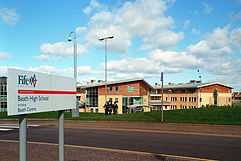Beath High School
 | |
| Motto | Surgo in Lucem |
|---|---|
| Established | 1910 |
| Type | Comprehensive |
| Religion | Non-denominational |
| Headteacher | Douglas Young |
| Location |
Foulford Road Cowdenbeath Fife KY4 9BH Scotland Coordinates: 56°06′49″N 3°21′25″W / 56.1135°N 3.357°W |
| Local authority | Fife Council |
| Students | 1200 |
| Gender | Mixed |
| Ages | 11–18 |
| Houses | Woodside, Kirkford, Stenhouse |
| Colours | |
| Publication | Beath High School Newsletter |
| Website | Beath High School |
Beath High School is a non-denominational state secondary school in Cowdenbeath, Fife. The school is run by Fife Council and the current roll stands at around 1200 pupils aged from 11 to 18. It serves Cowdenbeath and Kelty and the villages of Crossgates, Hill of Beath and Lumphinnans. Some pupils from Lochgelly and Ballingry attend the school. The current rector is Douglas Young.
History
Beath High School was established in 1910 as Beath Higher Grade School, catering for the children of local people who wished to proceed to higher education. This building was located on Stenhouse Street, close to the town centre. In 1964 a 'groovy' school was built on Foulford Road on the edge of the town. From 1964 until 1981 the two buildings operated as separate schools with the new building housing Beath Senior High School and catering for pupils perceived as more academic while the older building, then known as Beath Junior High School, provided a more vocational education up to O-grade standard. Pupils from Beath Junior High, Ballingry Junior High and Auchterderran High had an opportunity to move to Beath Senior High at the end of their 2nd year or for 5th and 6th year if they wished to take 'Higher Grade' qualifications. In 1981 the two schools were combined as Beath High School with the older building acting as an annex for S1 and S2 pupils. The opening of the new Lochgelly High School in 1987 resulted in a significant change in the school catchment area and a reduction in the school roll. This reduction in headcount together with the poor state of repair of the Old Beath building resulted in the closure and, in the 1990s, the partial demolition of the Stenhouse Street building. Part of the Old Beath building can still be seen on Stenhouse Street at the junction with King Street. By the 1990s, the Foulford Road building was also in a poor state of repair and struggling to provide suitable teaching accommodation with many classes being taught in outdoor huts that were supposed to be temporary but were there for twenty years. In 2003 a new school building was completed to the east of the previous Foulford Road site allowing everything apart from the games hall built in the early 1980s to be demolished and a new all-weather sports pitch to be built on the former school site.
Notable former pupils
Notable alumni of Beath High School include:
- Stuart Adamson, musician with the Skids and Big Country
- Sir James Whyte Black, winner of the Nobel Prize in Physiology or Medicine in 1988 for his work leading to the discovery of propranolol and cimetidine[1]
- Scott Brown, Celtic and Scotland midfielder
- Archie Campbell, Rangers, Cowdenbeath and Morton forward
- Harry Ewing, Baron Ewing of Kirkford, politician
- Jennie Lee, Baroness Lee of Asheridge, politician
- William McLaren, Artist and illustrator
- Iain Paxton, Scotland rugby international
- Ian Rankin, crime novelist
- Jim Leishman, (footballer, football manager, politician)
Current building
The current building stands on three floors, separated into three blocks, joined together at the back of the school.
Houses
Beath High School has three houses, each named after local areas around the school. Each house has its own colour and House Council, made up of two House Captains (male and female) from sixth year, and several junior (S1-4) pupils.
Woodside
Colour: Green and white
Kirkford
Colour: Blue
Stenhouse
Colour: Yellow
References
- ↑ Black, Sir James W. "Autobiography". The Nobel Foundation. Archived from the original on 6 February 2010. Retrieved 23 March 2010.